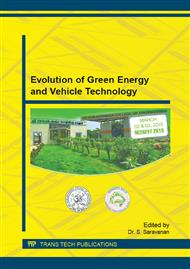[1]
P. Malaiyappan and N. Elumalai, Design, fabrication and performance analysis of single basin solar stills, Applied Mechanics and Materials, 372 (2013) 590–593.
DOI: 10.4028/www.scientific.net/amm.372.590
Google Scholar
[2]
P. Malaiyappan and N. Elumalai, Review of the productivity of various types of solar stills, Desalination and Water Treatment, DOI: 10. 1080/19443994. 2014. 909329 (2014) 1–12.
DOI: 10.1080/19443994.2014.909329
Google Scholar
[3]
P. Malaiyappan and N. Elumalai, Productivity enhancement of a single basin and single slope solar still coupled with various basin materials, Desalination and Water Treatment, (2015) DOI: 10. 1080/19443994. 2014. 1003973.
DOI: 10.1080/19443994.2014.1003973
Google Scholar
[4]
G.M. Cappelletti, An experiment with a plastic solar still, Desalination 142 (2002) 221-227.
DOI: 10.1016/s0011-9164(02)00203-5
Google Scholar
[5]
M.K. Phadatare and S.K. Verma, Influence of water depth on internal heat and mass transfer in a plastic solar still, Desalination 217 (2007) 267–275.
DOI: 10.1016/j.desal.2007.03.006
Google Scholar
[6]
A. E-Bahi and D. Inan, Analysis of a parallel double glass solar still with separate condenser, Renewable Energy, 17 (1999) 509-521.
DOI: 10.1016/s0960-1481(98)00768-x
Google Scholar
[7]
T. Elango and K. Kalidasa Murugavel, The effect of the water depth on the productivity for single and double basin double slope glass solar stills, Desalination 359 (2015) 82–91.
DOI: 10.1016/j.desal.2014.12.036
Google Scholar
[8]
A. Rahmani, A. Boutriaa and A. Hadef, An experimental approach to improve the basin type solar still using an integrated natural circulation loop, Energy Conversion and Management, 93 (2015) 298–308.
DOI: 10.1016/j.enconman.2015.01.026
Google Scholar
[9]
T. Elango, A. Kannan, and K. Kalidasa Murugavel, Performance study on single basin single slope solar still with different water nanofluids, Desalination, vol. 360 (2015) 45–51.
DOI: 10.1016/j.desal.2015.01.004
Google Scholar
[10]
S.R. Hansen, S.C. Narayanan, and K. Kalidasa Murugavel, Performance analysis on inclined solar still with different new wick, Desalination, 358 (2015) 1–8.
DOI: 10.1016/j.desal.2014.12.006
Google Scholar
[11]
M. Appadurai and V. Velmurugan, Performance analysis of fin type solar still integrated with fin type mini solar pond, Sustainable Energy Technologies and Assessments, 4 (2015) 30–36.
DOI: 10.1016/j.seta.2014.11.001
Google Scholar
[12]
M. Castillo-Tellez, I. Pilatowsky-Figueroa, A. Sanchez-Juarez, Experimental study on the air velocity effect on the efficiency and fresh water production in a forced convective double slope solar still, Applied Thermal Engineering, 75 (2015).
DOI: 10.1016/j.applthermaleng.2014.10.032
Google Scholar


